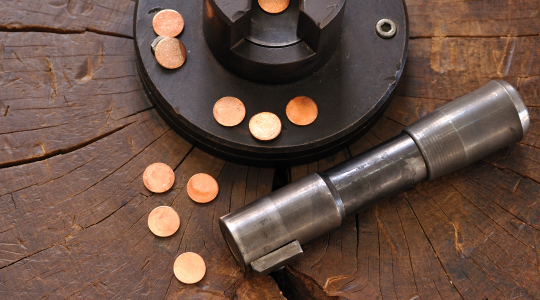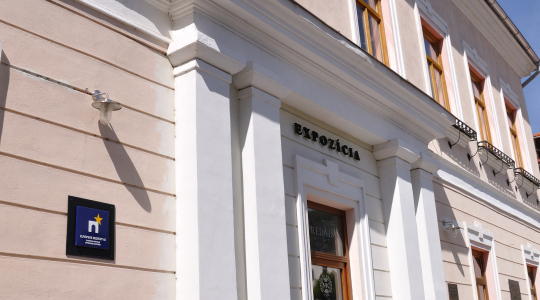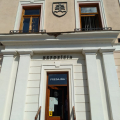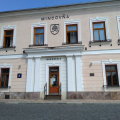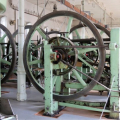Exposition tour
The Kremnica Mint is currently one of about eighty enterprises of its kind in the world, embodying the symbiosis of past and present, city and enterprise. It is a manufacturing enterprise and at the same time a place of culture and art, a symbol of state sovereignty. The obligation to build on the past and develop the level of development is best expressed in the text of the medal issued on the occasion of the opening of the new coinage: "I WILL PRESERVE AND ENHANCE YOUR FAMOUS HERITAGE".
The story of the Kremnica Mint became the oldest continuously producing enterprise in the world began to be written on November 17, 1328, thanks to the privilege of King Karol Robert. With this privilege, Kremnica also became a royal mining town and gained city privileges. This guaranteed her the development of a community of miners, as the king wanted it to be to the benefit of the region.
This privilege has been a key turning point in a series of economic and financial reforms and measures known in Europe as the Great Monetary Reform. Precious metals from the Central Slovak mining area, which were largely processed in the form of coins, played the most important role in this process.Together with Kremnica, three important Slovak mining towns gained the adjective of a precious metal mined in their territory or in their immediate vicinity. Kremnica is known as gold, Banská Štiavnica as silver and Banská Bystrica as a copper town. A bust of King Karol Robert is placed in front of the entrance to the establishment of the Kremnica Mint.
The Kremnica Mint was administered by the Comorian counts in the first century since its foundation. They had an overview of all stages of production, from ore mining to the minting of the final product - coins. From the high dignitaries of the country, the archbishop of Esztergom and the royal tavern also supervised the mintage. Working dies were kept closed with the seal of the mentioned dignitaries in a cabinet locked with three keys and the mintage was allowed only in the presence of the commissioners.
Thanks to the mint, Kremnica was one of the richest Hungarian towns in the 15th century, which was also reflected in the construction boom of the town, which was surrounded by walls. Before 1434, the mint objects were moved from the so-called old Comorian court inside the walls and have been located in the same place for almost 6 centuries. According to the inventory from the 15th century, the mint appears as a large object, which had at least 30 rooms and owned a rich arsenal of weapons.
The period of the greatest glory of the Kremnica Mint was accompanied by the use of a spindle embossing machine - a balancer. This machine was introduced in Kremnica by Daniel Warou, a well-known technician, engraver and medalist of Swedish origin, in 1710. It was possible to mint coins on such a machine in a modern way, which is still used today. Kremnica thus became the first place to use a balancer for coinage in Central Europe.
The historic mint buildings, resting on the city walls, were completed in the 1980s into a modern enterprise that surpassed other mints in Hungary with its technologies.From the end of the 19th century, the mint began minting crowns, the number of which increased sharply compared to previous types of coins. During this period, the Kremnica Mint also became the only mint in the whole of Hungary.
After 1918 and during the entire duration of the common state, it was the only Czechoslovak mint. The mint was also affected by the events during both world wars. After the First Worls War, only empty buildings remained from the mint. All the equipment and supplies of precious metals were taken to Budapest. At the end of World War II, a German commando destroyed the equipment of the entire minting hall with explosives. In both cases, the company got up in a very short time.
Later, in 1986, a new plant outside the city was completed, to which the entire coin production was moved so as not to disturb the peaceful atmosphere of the historic center. The production of medals remained in the original building. Until the early 1990s, Kremnica mint was the only producer of coinage for Czechoslovakia. Since January 1, 1993, the Mint has been fulfilling this role in the service of our new Slovak Republic. January 23, 1993 became the day of the birth of new Slovak coins.
At the end of 2008, the Kremnica Mint also issued new Slovak euro coins. These have already been manufactured in a new modern forge, which was created by a general reconstruction of the production premises in the original building in the historic center of Kremnica.
Kremnica gold ducats and silver coins
The highlight during the formation of the Kremnica Mint was the introduction of the minting of the Hungarian ducat from the 14th century, which was considered the hardest currency in the Middle Ages. This type of coin was called floren (after the Italian city of Florence, where it was minted) and was minted in several places throughout Europe. However, the Kremnica florins were undoubtedly one of the most sought-after for their high purity of 23 carats and 9 grains and the content of Kremnica gold, which was famous for its quality. Their minting began in 1335 at the latest, and the last gold ducats, which served as currency, were minted at the Kremnica Mint in 1881. Until the end of the 15th century, an average of 250 000 coins a year were minted per year, with the strongest years issued up to 500 000 coins from almost 1500 kg of gold. Today it is possible to see the exposition of Kremnica ducats in the company store of Mincovňa Kremnica, where we offer a cross-section of the history of their development and appearance. Later, their numbers gradually began to decline and ducats began to give way to coins of cheaper precious metals. An example are silver tolars, the minting of which began in the Kremnica Mint as one of the first as early as 1499. The tolar currency in Hungary lasted until the introduction of the crown currency. Tolars, pennies, denas were minted of silver and their weight as well as dimensions often changed. However, it is estimated that around 3000 to 6000 kg of silver per year were processed in the best years.
Interesting facts, or this "BEST" of Kremnica Mint
During its existence, a total of 21.5 million pieces of gold ducats - florins - were minted at the Kremnica Mint. Their total value of gold at today's price of this commodity exceeded three billion euros.
The Kremnica Mint is probably the longest continuously operating company in the world. There are, of course, older companies, but none of them have managed to maintain their production continuously from its establishment to the present.
Mincovňa Kremnica is one of only about 80 state-owned mints worldwide.
The largest silver medal in the world was minted in the Kremnica Mint on the occassiion of the completion of the pontificate of Pope John Paul II. in 2006. Parameters: Ag 925/1000, 155 mm, 1710 g.
The minting of medals in the Kremnica Mint has a tradition of more than 500 years. The first known embossed medal was a medal on the occasion of the coronation of Ladislav II. under the Hungarian king from 1508.
During the reign of Maria Theresa, more coins were minted at the Kremnica Mint per year than at all other mints in the Habsburg Monarchy combined.
Trade and exbibition of Mincovňa Kremnica is housed in almost 600 years of original reconstructed historical premises from 1430, which are part of the European Cultural Heritage.
The Kremnica Mint was considered the vein of Hungarian queens in the High Middle Ages and early modern times. This happened in connection with the declining production of gold at the beginning of the 15th century and the subsequent decision of King Sigismund of Luxembourg to leave pensions from the Central Slovak mining towns and the Kremnica Mint to his wife Barbora.
A patent for a spindle stamping machine - balancer - was made in the Kremnica Mint. Its inventor was Daniel Warou, a Swedish medalist and engraver operating the Kremnica Mint. The Kremnica Mint was the first to use this machine, and visitors can still try it out and use it to mint a commemorative coin.
Mint Kremnica š.p. is the last place in Europe where punching machines known as Vulcans are still used in production. During the tour of the old mint, visitors can see the minting of coin tickets or badges on these machines.
Virtual tour
If you do not have a trip directly to Kremnica, but still wanted to visit our exhibition, we have a solution for you. Like it, enter our virtual exhibition.
Visit registration form
Approximate calendar.
It is important to register for the exhibition in advance (application / telephone).
